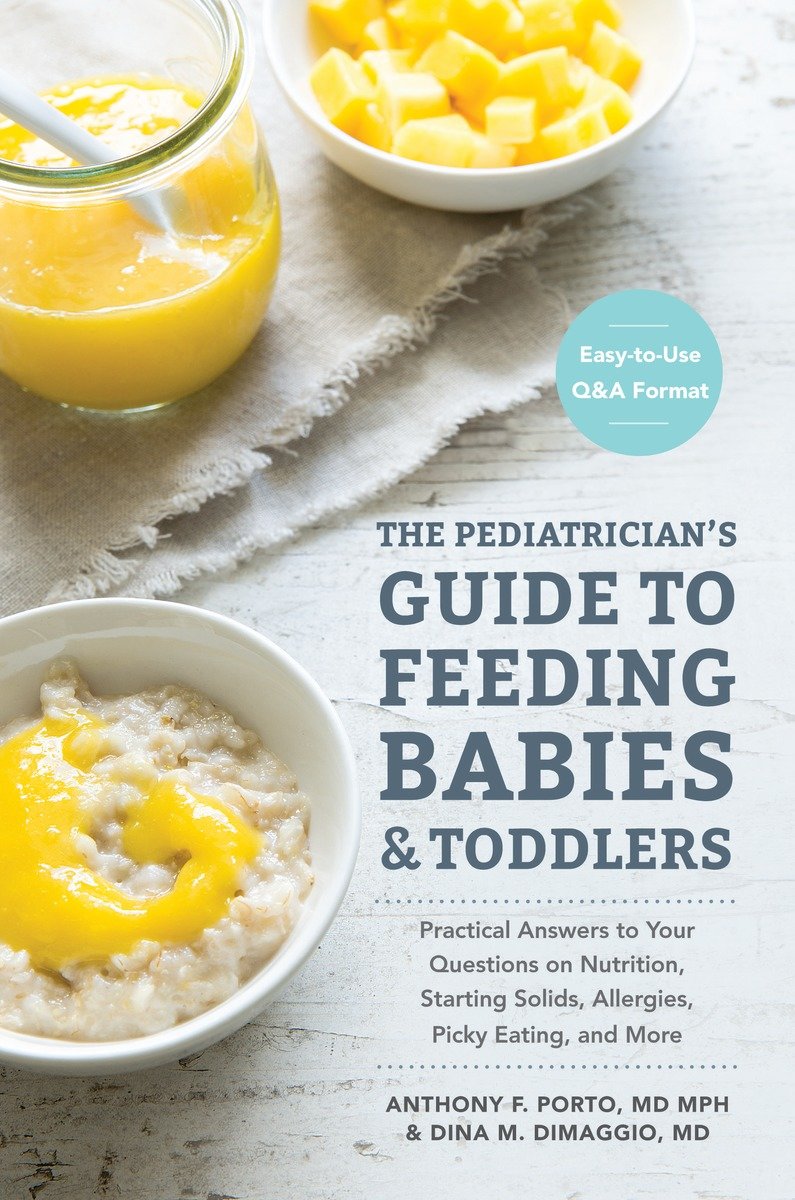Practical Answers To Your Questions on Nutrition, Starting Solids, Allergies, Picky Eating, and More (For Parents, By Parents): The Pediatrician’s Guide to Feeding Babies and Toddlers
18.99 JOD
Please allow 2 – 5 weeks for delivery of this item
Add to Gift RegistryDescription
A comprehensive manual for feeding babies and toddlers during the crucial first years of life, written by a team of medical experts who are also parents.All Your Questions about Feeding, Answered. The choices of when, how, and what to feed your baby can be overwhelming. With The Pediatrician’s Guide to Feeding Babies and Toddlers, you have the expertise of a team of pediatric medical and nutritional experts—who also happen to be parents—in a comprehensive manual that takes the guesswork out of feeding. This first-of-its-kind guide provides practical, easy-to-follow advice to help you navigate the nutrition issues, medical conditions, and parenting concerns that accompany feeding. With recipes, parenting stories, and recommendations based on the latest pediatric guidelines, this book will allow you to approach mealtime with confidence so you can spend more time enjoying your new family.
Additional information
| Weight | 0.41995 kg |
|---|---|
| Dimensions | 1.524 × 15.494 × 23.114 cm |
| by | |
| format | |
| Language | |
| Pages | 256 |
| publisher | |
| Year Published | 2016-4-5 |
| Imprint | |
| Publication City/Country | USA |
| ISBN 10 | 1607749017 |
| About The Author | Dina DiMaggio is a board certified pediatrician working at Pediatric Associates of NYC and NYU Langone Medical Center. She completed her medical training at Albert Einstein College of Medicine, Children’s Hospital at Montefiore, and Memorial Sloan Kettering Cancer Center. She has received numerous research awards, Patient’s Choice awards, compassionate doctor recognition, and was featured in the New York Times Magazine as a Super Doctors in 2014 and 2015 New York Rising Star. She is dedicated to educating parents on baby and toddler nutrition and gives talks to parents throughout New York. Anthony F. Porto is a board certified pediatric gastroenterologist, an Assistant Professor of Pediatrics, and Associate Clinical Chief at Yale University. He completed his medical training at Tufts University, Children’s Hospital at Montefiore, and Columbia University. He has received numerous awards including the Norman J. Seigel Award at Yale University for leadership and outstanding clinical care and Physician of the Year at Columbia University. He has been named Castle Connolly Top Doctors since 2012. Anthony is interested in nutrition, especially in the care of children with difficulty gaining weight, feeding issues, and celiac disease. |
| Table Of Content | Introduction vii How to Use this Book viii Chapter 1: 0 to 3 Months 1 Expected Developmental Milestones 2 Basic Nutritional Guidelines 4 Feeding Options 10 Breastfeeding 10 Formulas 21 Bottles and Nipples 31 Expected Growth 35 Medical Concerns 37 Milk Allergy or Intolerance 37 Spit-Up and Gastroesophageal Reflux 43 Constipation 46 Healthy Recipes for Parents 48 Pistachio-Toasted Salmon 51 Veggie and Cheese Mini Frittatas 52 Hearty Bean and Kale Soup 53 Easy Cheesy Burgers 54 Oatmeal Power Cookies 55 Red, White, and Blueberry Overnight Oats 56 Chapter 2: 4 to 6 Months 57 Expected Developmental Milestones 58 Basic Nutritional Guidelines 59 Typical Menus for 4 to 6 Months 60 Introduction of Solid Foods 61 Preparing Your Own Baby Food 68 Special Diets 72 Expected Growth 79 Medical Concerns 79 Food Allergies 79 Constipation and Stooling Patterns 89 Healthy Recipes for 4 to 6 Months 90 Prune Puree 92 Double Duty: Prune Pops 93 Mango Apricot Puree 94 Double Duty: Mango Apricot Yogurt Parfait 95 P2 Puree 96 Double Duty: P2 Smoothie 96 Roasted Butternut Squash Puree 97 Double Duty: Spiced Butternut Squash Soup 99 Zucarrot Puree 100 Double Duty: Zucarrot Soufflé 101 Roasted Banana and Greek Yogurt Puree 102 Double Duty: Banana Bites 103 Chapter 3: 7 to 8 Months 105 Expected Developmental Milestones 106 Basic Nutritional Guidelines 107 Typical Menu for 7 to 8 Months Months 107 Balancing Solid Foods with Breast Milk or Formula 109 Teething 110 Expected Growth 111 Medical Concerns 112 Failure to Thrive 112 Celiac Disease 114 Gastroesophageal Reflux 115 Healthy Recipes for 7 to 8 Months 116 Sweet and Green Puree 117 Banana-Avocado Smoothie 118 Blueberry-Pear Protein Puree 119 Dairy-Free Sweet Potato Pudding 120 Mama’s Chicken Soup 121 Chapter 4: 9 to 12 Months 123 Expected Developmental Milestones 124 Basic Nutritional Guidelines 125 Typical Menu for 9 to 12 Months 126 Finger Foods 127 Expected Growth 131 Medical Concerns 131 Diarrhea 131 Anemia 135 Food Allergies 138 Healthy Recipes for 9 to 12 Months 141 Broccoli-Lentil Soup 142 Beef-Veggie Bolognese Sauce with Quinoa 143 Salmon and Sweet Potato Frittata 144 Pulled Apricot-Raisin Chicken 145 Spinach-Quinoa Bites 146 Chapter 5: The Toddlers Years 147 Expected Developmental Milestones 148 Basic Nutritional Guidelines 150 Typical Menu for Toddlers 151 Milk and Dairy Products 153 Picky Eaters 162 Expected Growth 165 Medical Concerns 165 Diarrhea 165 Constipation and Potty Training 167 Autism Spectrum Disorder and Diet 168 Healthy Recipes for Toddlers 171 Eggplant-Zucchini Lasagna 172 Chicken-Vegetable Meatballs in Sweet and Sour Sauce 173 Sunflower Seed Butter and Fruit Quesadilla 174 Chicken Chili 175 Ricotta Cinnamon Pancakes 176 Panko Fish Sticks 177 Zucchini-Apple Muffins 178 Brown Rice, Broccoli, and Chicken Casserole 179 Almond Butter Bites 180 Strawberry-Banana Ice Cream 181 Chapter 6: Common Medical Concerns and Additional Resources 183 Common Gastrointestinal and Nutritional Conditions 184 Constipation 184 Eosinophilic Esophagitis 189 Failure to Thrive and Feeding Problems 190 Gastroesophageal Reflux and Gastroesophageal Reflux Disease 194 Gluten-Related Disorders 199 Gluten-Related Disorders 204 Allergic Conditions 204 Cow’s Milk Protein Allergy or Allergic Proctocolitis 207 Food Protein-Induced Enterocolitis) 208 Diphenhydramine Dosing (Brand Name: Benadryl) 209 Visiting a Specialist 211 Epinephrine Dosing 210 Dietitian 211 Pediatric Gastroenterologist 212 Allergist 213 Table of Major Nutrients, Their Function, and Recommended Intake 216 Monitoring Your Child’s Growth 220 Helpful Websites for Parents 226 About the Authors 227 The Contributors 228 Acknowledgments 231 References 233 Index 244 |
| Excerpt From Book | Introduction The Pediatrician’s Guide to Feeding Babies & Toddlers combines the expertise of a group of pediatricians, a dietitian, a lactation consultant, and two chefs. More importantly, we are also parents to a total of thirteen children. Most of us met during our medical training and cultivated strong friendships during our many long days and nights working together in a hospital. After completing our training over a decade ago, we felt that we were prepared to practice medicine. We couldn’t imagine, however, how much our careers would be enhanced by our roles as parents. When Dina’s daughters, Julia and Evelyn, were born just twenty-one months apart, Dina realized she didn’t really know how a mother was feeling until she was a mother herself. As we were writing this book, Anthony was learning the ins and outs of fatherhood as he cared for his newborn son, Sebastian. Persephone was busy chasing after her twin toddler boys, Sean and Aaron. Janet bonded with her newborn daughter, Annie, and toddler son, Sid. Liza was busy helping her daughters, Emilia and Anna, with their homework and coordinating after-school activities; Susan was going on college tours with her son, Caleb; Alison developed recipes while taking care of her newborn son, Azriel; and Dini cooked alongside her little girl, Andi, while taking care of her newborn daughter, Jolie. Caring for our own children has helped us to understand the fears, anxieties, and questions of parents on a deeper level. Over the years, we have discussed how often parents would ask the same questions about feeding their children. We found that parents did not know where to turn for guidance and became frustrated with trying to find the right information on their own. We also know that Google-searching (yes, we all do this, often bleary-eyed in the middle of the night!) can lead to additional anxiety and confusion. We believe that feeding should be fun, stress-free, and family-oriented quality time. We created this book as a resource to provide easy access to common feeding questions from the minute an infant is born through the toddler years. Dina, a general pediatrician, and Anthony, a pediatric gastroenterologist, who are the lead authors, assembled a team that includes a pediatric allergist, a developmental-behavioral pediatrician, a pediatric dietitian, and a lactation consultant, along with two family chefs to help answer common feeding and nutrition questions. This book was also reviewed for completeness and accuracy by an additional board-certified general pediatrician. The goal is to present the most current evidence-based information in an easy-to-read question-and-answer format. We understand the reality of parenthood and use this knowledge, along with our medical acumen, to develop practical approaches to the feeding and care of infants and toddlers. We want the best beginnings for the children we take care of, for our own children, and for your children. How to Use This Book We have divided the book into five age groups from the newborn period to the early toddler years. Every section contains expected developmental milestones, basic nutritional guidelines, expected growth, common medical concerns, and ends with examples of developmentally appropriate recipes that contain tips to alleviate potential medical issues encountered at that stage. In chapter 1, we discuss infants from birth to 3 months of life and end with healthy recipes for breastfeeding moms and hungry caregivers. In chapter 2, the 4 to 6 months group, we discuss the new challenge of how best to feed a baby solid foods and answer questions that commonly come up at this early stage of infant feeding. In chapters 3 and 4, we discuss the 7 to 8 month and 9 to 12 month age groups, respectively. As your child increases intake of solid foods, we will address common questions such as balancing solid food and milk intake, how to transition to finger foods, and choking hazards. We will discuss topics such as celiac disease, failure to thrive, iron deficiency anemia, and diarrhea. In chapter 5, we focus on the early toddler years, guiding parents on how to deal with picky eaters and providing healthy choices as children enter the school years. We end with chapter 6, which discusses the most common medical concerns in more detail and includes additional references and resources. We designed this book not only to be a reference, but also a reassuring guide through the stage that your baby is in or about to go through. You can, therefore, use this book in multiple ways—by quickly finding out the answer to a current concern, by reading the section that your baby is in now or about to be in, by reading the entire book and then referring back to particular sections later as you need them, or by referencing chapter 6 to find out more details about a specific medical concern. We look forward to sharing our knowledge about infant and toddler nutrition, learned from our many collective years of caring for children in the medical field, combined with our practical experiences as parents ourselves. Raising a child provides you with some of the most extraordinary times in your life, but as we know, it can also be overwhelming. We hope to ease some of the stress of this journey by providing you with information you can trust and valuable insights into the world of childhood nutrition, so you can spend less time searching for answers and more time enjoying these fleeting moments. |
Only logged in customers who have purchased this product may leave a review.






Reviews
There are no reviews yet.